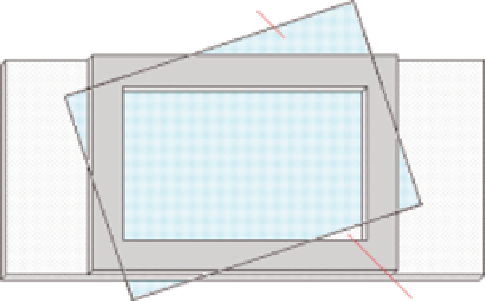Environmental Engineering Reference
In-Depth Information
Cover glass
Sample well
FIGURE 15.13
Sedgewick/Rafter counting cell. (From USAE, Analyzing plankton tows, pumped samples,
and shallow water samples, Engineering Research and Development Centerweb site.)
Direct enumeration is usually prohibitively expensive and technically impossible for most moni-
toring programs. Further, in many lakes, a large portion of the algal biomass may be unidentiiable
by most experts (subsequently these are appropriately called little round green things [LRGTs] and
little round blue-green things [LRBGTs]).
Other methods, such as imaging low cytometry, are also often used to assess phytoplankton
biovolumes and functional group compositions.
15.3.1.1.3.2 Enumeration by Plant Pigments
Phototrophs or photoautotrophs use light as an
energy source for photosynthesis. They have certain pigments that absorb light, which raises the
energy level of the pigment and provides the energy source. Similar to the Redield ratios, the mass
(or molar rations) for phytoplankton are approximately (Chapra 1997):
100
gD: C:
40
7200
mgN:
1000
mgP:
1000
mgA
where g
X
= mass of element
X
(g) and mg
Y
= mass of element
Y
(mg). The terms D, C, N, P, and
A refer to dry weight, carbon, nitrogen, phosphorus, and chlorophyll-a, respectively. It should be
noted that chlorophyll-a is the most variable of these quantities with a range of approximately 500-
2000 mgA (Chapra 1997). Although the stoichiometry is variable, if chlorophyll can be measured
then an estimate of the phytoplankton biomass can be obtained.
An advantage of using plant pigments, particularly chlorophyll (the green pigment), over other
metrics used for enumeration (e.g., biomass, counting, etc.) is that it is relatively fast and inexpensive
to measure. There are several forms of chlorophyll, but the most common pigment (and form used
for enumeration) is chlorophyll-a. Since chlorophyll absorbs light, the amount of light absorbed can
be used as an indication of the amount of chlorophyll present (e.g., using a spectrometer; Method
106-a in Standard Methods, e.g., APHA 1995). When chlorophyll-a absorbs light, it becomes excited
and releases the light (luoresces) at a lower wavelength. Therefore, an alternative method measures
chlorophyll by luorescence (Method 106b in Standard Methods). The wavelengths of light absorbed
by chlorophyll-a peak at 665 nm (blue) and 465 nm (red), while chlorophyll-a luoresces at 673 and
726 nm. The peak absorbance is near the peak of solar incident light, which makes chlorophyll-a an
effective pigment (Figure 15.14).
There are a variety of other plant pigments that may participate in the process of photosynthe-
sis, and the quantity (e.g., stoichiometry) and form of these pigments vary between different algal
groups. These pigments are often used in the enumeration of these separate groups. For exam-
ple, phycobilins are water-soluble pigments that occur in Cyanobacteria and Rhodophyta. These

Search WWH ::

Custom Search